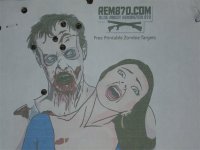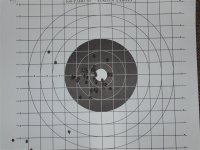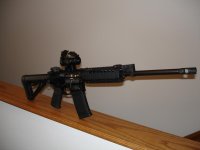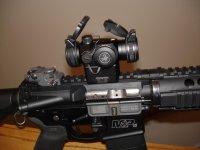You are using an out of date browser. It may not display this or other websites correctly.
You should upgrade or use an alternative browser.
You should upgrade or use an alternative browser.
Vortex Red Dot?
- Thread starter ttriton
- Start date
- Status
- Not open for further replies.
Register to hide this ad
Moe Mentum
Member
Strikefire II Has both the red and green dot. I do use both of them in certain situations.
warriorking
Member
- Joined
- Feb 21, 2016
- Messages
- 76
- Reaction score
- 61
My Strikefire II only does red but I'm happy with it. There are things the more expensive sights will do but you pay for them. Most impressive is that the higher priced sights will stay turned on for a very long time. The Vortex sights won't do that. It's good to know your sight is going to be ready to operate in a moment's notice. Aimpoint in particular makes sights that stay on for over a year at a time.
Westie1
Member
Went with the strikefire 2 r/g series. Several reasons why. On a fixed income, so have to go based on budget. The option of either the red or green dot allows me to use the one that best fits lighting conditions. Finally,
with my eyesight/prescription I see less blur/bloom with the larger dot.
with my eyesight/prescription I see less blur/bloom with the larger dot.
highsideforum
Member
- Joined
- Oct 12, 2016
- Messages
- 38
- Reaction score
- 4
I'm looking to add a red dot to my Sport 2 this week.
I'm between the Vortex Sparc AR and the Vortex Spitfire AR.
Those running either.
Is everything necessary to mount these optics to a Sport 2 included when you buy them?
If not, what EXACTLY do you need to buy and modify?
How are the Vortex's shooting and how is their reliability?
Thanks in advance.
(I'm also considering the Primary Arms as well)
Primary Arms 3X Compact Prism Scope with the Patented ACSS 5.56 Reticle-CP3
I'm between the Vortex Sparc AR and the Vortex Spitfire AR.
Those running either.
Is everything necessary to mount these optics to a Sport 2 included when you buy them?
If not, what EXACTLY do you need to buy and modify?
How are the Vortex's shooting and how is their reliability?
Thanks in advance.
(I'm also considering the Primary Arms as well)
Primary Arms 3X Compact Prism Scope with the Patented ACSS 5.56 Reticle-CP3
Rastoff
US Veteran
Trijicon RMR.
I have tried many red dots. I won't waste my money again on a cheap one.
I have tried many red dots. I won't waste my money again on a cheap one.
I have tried many red dots. I won't waste my money again on a cheap one.
Cheap means different things to different people. I had people give me "cheap" red dots (the $25 kind) and I tossed them in a box about 10 minutes later. But $200 doesn't really seem "cheap" to me. I'm sure there are those that think it is. If you have a problem with the Strikefire II, Sparc, etc. can you please explain what that problem is? I know about things like better build quality and always on operation. But are there other things I'm missing? I'm not arguing with your choice at all. I just want to understand it a little better. I actually plan on getting a better red dot eventually but I was dealing with a budget when I bought my Strikefire II. In my family we give each other money to spend on things. It isn't money we stick in our pocket and save for something better. We expect each other to have something to show come birthdays, Christmas, etc.. I certainly have more expensive scopes than the Strikefire II. But beyond the things I mentioned I really don't know what all the differences are. Can you educate us?
ChattanoogaPhil
Member
- Joined
- Oct 18, 2009
- Messages
- 14,601
- Reaction score
- 20,622
Trying to decide which red dot sight to put on my SportII.
Looking at the SpitfireII, the Sparc AR or Sparc. Do you recommend just the red dot or the red/green?
The Spitfire is a "prism" design much different than a red dot reflex design like the Sparc.
The Spitfire has an etched reticle. One of the benefits is for those with astigmatism the reticle will be sharp, not blurry or distorted like with the Sparc (any red dot reflex design). Another positive is that even if the battery is dead the etched reticle remains useful. The negatives of the prism design is that you don't have unlimited eye relief like a red dot, and co-witnessing with irons will be blurry even though it's rated at 1x. The Spitfire 1x is also on the hefty side at nearly 3/4 pound.
Weighing the positives and negatives between prism and reflex should help you in the decision process.
Between the Sparc and Sparc AR, the differences are pretty well described by Vortex.
As far as multi-color.... eh.... The design and application of the optic is what's important... playing with it like a kaleidoscope not so much.
Happy optics hunting.
Last edited:
I just put a Strikefire II on my New Sport, Now I am new to optics so no expert! For me I think my Strikfire looks well made,has clear glass and am still playing with the dot color to see what is good for me. I can hit the paper at 100 yards with 63 y/o eyes and Bi Focals and can hit a Zombie in the head at 100 yards :O Plus I can miss his head alot as well lol,, Vortex has a GREAT warranty and a good price.. I can not see putting a 500$ Scope or Red Dot on a 600 $ rifle just to hit paper! NOW if I was hunting I would want the best scope I could afford so then 6/1000$ scope would be justified for me! As mentioned we all have our views , and Thanks for this thread I have learned alittle more 
Attachments
Disabled1
US Veteran
Is the PRIMARY ARMS red dot better than the BUSHNELL TRS-25?
[ame="https://www.amazon.com/Primary-Arms-Micro-Sight-Removable/dp/B00NC1G0KI/ref=sr_1_38?s=sporting-goods&ie=UTF8&qid=1476638061&sr=1-38&keywords=vortex+strikefire+2"]Amazon.com: Primary Arms Micro Red Dot Sight w/ Removable Base - 2 MOA Dot MD-RBGII: Sports & Outdoors[/ame]
[ame="https://www.amazon.com/Bushnell-Trophy-TRS-25-Reticle-Riflescope/dp/B00200E0HM/ref=sr_1_20?s=sporting-goods&ie=UTF8&qid=1476638061&sr=1-20&keywords=vortex+strikefire+2"]Amazon.com : Bushnell Trophy Red Dot TRS-25 3 MOA Red Dot Reticle Riflescope, 1x25mm (Matte), Colors May Vary : Rifle Scopes : Sports & Outdoors[/ame]
[ame="https://www.amazon.com/Primary-Arms-Micro-Sight-Removable/dp/B00NC1G0KI/ref=sr_1_38?s=sporting-goods&ie=UTF8&qid=1476638061&sr=1-38&keywords=vortex+strikefire+2"]Amazon.com: Primary Arms Micro Red Dot Sight w/ Removable Base - 2 MOA Dot MD-RBGII: Sports & Outdoors[/ame]
[ame="https://www.amazon.com/Bushnell-Trophy-TRS-25-Reticle-Riflescope/dp/B00200E0HM/ref=sr_1_20?s=sporting-goods&ie=UTF8&qid=1476638061&sr=1-20&keywords=vortex+strikefire+2"]Amazon.com : Bushnell Trophy Red Dot TRS-25 3 MOA Red Dot Reticle Riflescope, 1x25mm (Matte), Colors May Vary : Rifle Scopes : Sports & Outdoors[/ame]
Is the PRIMARY ARMS red dot better than the BUSHNELL TRS-25?
Amazon.com: Primary Arms Micro Red Dot Sight w/ Removable Base - 2 MOA Dot MD-RBGII: Sports & Outdoors
Amazon.com : Bushnell Trophy Red Dot TRS-25 3 MOA Red Dot Reticle Riflescope, 1x25mm (Matte), Colors May Vary : Rifle Scopes : Sports & Outdoors
Not much in it really, I slightly favor the Primary Arms because I prefer the smaller 2MOA dot, but the 3MOA dot on the TRZ-25 is by no means bad and some prefer a larger dot for CQB use, personal preference.
Primary Arms warranty is no hassle, which is a plus too. You'll do fine with either tbh. Wait for a sale the TRS-25 was available for $59.99 last week, and the PA regularly goes on sale for that price tooo.
Plazzman
Member
Just added a Vortex SPARC II to my Sport. Did a lot of research and did not want to spend to much for a red dot, so this is the one that I went for that would not break the bank.
As for now I have not hand time to sight it in. The 2 MOA red dot is very clear, love the way the controls are set up and that it comes with front and back flip up covers.
As you can see I have the height set up as absolute co-witness to my front and back sights. My front sight post is not fixed so I can fold it down not having to co-witness with the red dot. This is just a preference of mine which some would not care for, as they say "To each their own".
As for now I have not hand time to sight it in. The 2 MOA red dot is very clear, love the way the controls are set up and that it comes with front and back flip up covers.
As you can see I have the height set up as absolute co-witness to my front and back sights. My front sight post is not fixed so I can fold it down not having to co-witness with the red dot. This is just a preference of mine which some would not care for, as they say "To each their own".
Attachments
Last edited:
highsideforum
Member
- Joined
- Oct 12, 2016
- Messages
- 38
- Reaction score
- 4
Just added a Vortex SPARC II to my Sport.
Looks great.
Why didn't you go with the updated version in the Sparc AR ????
Plazzman
Member
Looks great.
Why didn't you go with the updated version in the Sparc AR ????
Did not like the AAA battery set up. I read that the disc type battery last longer than the triple A, but price wise between both batteries I am sure the triple A is cheaper.
Rastoff
US Veteran
This is an excellent question and I'll do my best to fully answer it.Cheap means different things to different people. I had people give me "cheap" red dots (the $25 kind) and I tossed them in a box about 10 minutes later. But $200 doesn't really seem "cheap" to me.
But beyond the things I mentioned I really don't know what all the differences are. Can you educate us?
You mentioned build quality and always on, but what do those things mean?
The long battery life is self explanatory. If you're going to use a red dot for self-defense, not having to turn it on when you need it should be a no brainer. This alone would put optics like the TRS-25 out of the running if the gun is for self-defense.
Build quality is a more complicated subject. The most obvious aspect is durability. What material it's made of, how it's constructed and how it's engineered are all part of build quality. Ease of operation is also part of build quality. How easy is it to adjust? When adjusted, how well does it stay?
Then people talk about quality of customer service. Primary Arms, Vortex and Trijicon all have fantastic customer service. I don't know about cheaper brands, but then does it matter? I mean, great customer service is...well...great, but wouldn't it be better if you never needed it? So, I want a device that won't break in the first place.
Ultimately it comes down to how you're gonna use it. If you just want to poke some holes in paper at the range, just about any optic will do. Or will it? When I go to the range, the amount of fun I have is proportional to how much work I have to do. If the gun or optic breaks, I'm not having fun. So, I want an optic that isn't going to break, that won't need to be zeroed every time I go to the range and that was easy to zero in the first place.
Have you ever tried to adjust a scope and felt that the adjustments were not positive? Or that they felt kind of squishy? I have. It's much easier to adjust the optic if the clicks are positive and easy to get to. For example, I had a Vortex Sparc, the windage adjustment slot was shaped so a coin could be used to adjust it. However, it was placed too close to the battery compartment and a coin couldn't be used to adjust it because the coin would hit the battery compartment wall. That's a design flaw. Not horrible, but frustrating.
What this means for me is no TRS-25 or similar optics. I have a Primary Arms Advanced Micro Dot. I've had to send it back once because the windage adjustment quit working. They fixed it without question and I do think it's a decent enough optic, but it's no Trijicon.
I don't know if this dissertation answers your question. I'm just tired of stuff that doesn't work.
The Trijicon RMR is smaller and lighter than the TRS-25, PA Advanced Micro Dot and similar optics. The dual illuminated version requires no batteries. They are beyond tough. They have clear glass. When you absolutely, positively need an optic to work, these will.
The Aimpoint optics are also very tough, easy to operate and reliable. I've used the Comp M3 and it's a really nice optic. I haven't used the T-2 or H-1, but I'm sure they're fantastic as well. These are made in Italy. I admit that being made in the US biases me toward the Trijicon.
Ultimately you'll have to decide for yourself. All of these are a lot of money. Even $90 is nothing to sneeze at. I've done the cheap ones and I'm willing to take the time to save up to get the right one. If that means my wife gives me $25 at my birthday and I save it toward something more expensive, that works for me. In fact, we both do that for stuff we want.
- Status
- Not open for further replies.
Similar threads
- Replies
- 4
- Views
- 2K
- Replies
- 7
- Views
- 968
- Replies
- 5
- Views
- 1K
- Replies
- 5
- Views
- 1K
- Replies
- 22
- Views
- 3K






